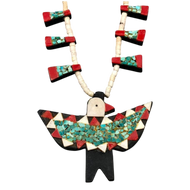The Depression Era Thunderbird Tab Necklace
Posted by Jim Olson on Sep 4th 2025
What we know as the “Thunderbird Tab Necklace” traces its origins to the Great Depression, one of the most challenging economic periods in American history. During this time, Native artisans from the Santo Domingo Pueblo, now known as the Kewa Pueblo in New Mexico, faced shortages in traditional jewelry-making materials due to the collapse of the economy. Despite these hardships, there remained a modest demand for Native goods among tourists and traders, and the artists still needed to create products to earn a living.
In response to these difficult circumstances, artists adapted with remarkable ingenuity. Drawing from whatever materials they could find, they began crafting jewelry from discarded and repurposed items such as old battery casings, broken records, toothbrush handles, plastic combs, and other found objects. These unconventional materials were cut and shaped by hand, then combined with available bits of turquoise, shell, and early trade beads. The result was a lightweight necklace that looked attractive to the eye, but cost very little to produce.
While several versions of these necklaces emerged during the era, one motif became prominent: the Thunderbird. A popular symbol in many Native cultures, the Thunderbird was represented as a flat pendant shape with simple, geometric wings and head. These stylized Thunderbird figures quickly became the centerpiece of many tab-style necklaces. They appealed to tourists who, even during those hard times, found fascination in the Southwestern art and symbolism.
Each Thunderbird tab necklace from this era tells a story, not just of artistic expression, but of resilience and adaptation. Today, authentic examples are prized by collectors, museums, and scholars for a number of reasons:
- Historical significance: These necklaces represent a unique chapter in American history. A time when artists demonstrated resourcefulness in the face of scarcity.
- Material uniqueness: The use of recycled materials such as records, battery casings, and toothbrush plastic gives each piece a distinct charm that is not easily replicated.
- Handcrafted artistry: Every necklace is a reflection of manual skill, care, and tradition passed down through generations of Pueblo jewelers. Despite using nontraditional materials, the artisans preserved the core techniques of their craft.
- Rarity and fragility: Because many of the materials used were fragile or unstable, few necklaces have survived in good condition. Well-preserved pieces with intact pendants, original beads, and that are authentically old, are harder to find.
While many of these necklaces were sold for a dollar or less in their day, they now routinely fetch several hundred dollars—or more—depending on condition and completeness. Not a bad return on what was once considered a low-cost souvenir trinket made from scraps.
Legacy of the Thunderbird Tab Necklace
The legacy of the Thunderbird tab necklace has endured for close to a century now. It stands as one of the most recognizable forms of Southwestern Native American jewelry from the first half of the 1900s. More than a nostalgic artifact, it continues to influence contemporary jewelers, some of whom are creating modern interpretations using similar designs, though often with more durable materials than were available to their predecessors.
Still, it is the original Depression-era pieces that remain meaningful with hard-core collectors. These necklaces serve as a reminder that creativity often flourishes in times of hardship. They represent more than artistic adaptation, they embody the will to survive during one of the most trying times in modern American history. From humble and unconventional materials, artists created beauty that still resonates nearly a century later, proof that the human spirit, much like the mythgc Thunderbird itself, is capable of rising above adversity.
Jim Olson © 2025

